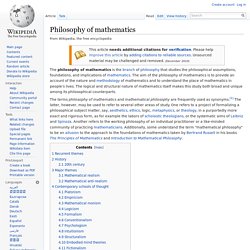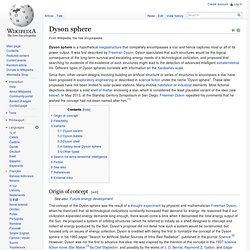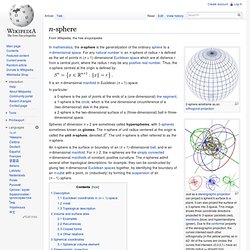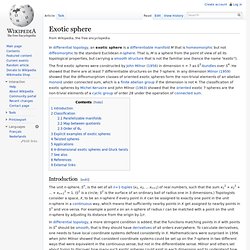

Mosek ApS. Ursula Anne Whitcher. Philosophy of mathematics. The terms philosophy of mathematics and mathematical philosophy are frequently used as synonyms.[1] The latter, however, may be used to refer to several other areas of study.

One refers to a project of formalizing a philosophical subject matter, say, aesthetics, ethics, logic, metaphysics, or theology, in a purportedly more exact and rigorous form, as for example the labors of scholastic theologians, or the systematic aims of Leibniz and Spinoza. Another refers to the working philosophy of an individual practitioner or a like-minded community of practicing mathematicians. Additionally, some understand the term "mathematical philosophy" to be an allusion to the approach to the foundations of mathematics taken by Bertrand Russell in his books The Principles of Mathematics and Introduction to Mathematical Philosophy. Recurrent themes[edit] Recurrent themes include: Jmccanneyscience.com : How to contact us. Calculateprimes sub-page James M.

McCanney, M.S. Physics This web page was created to convey information to the public regarding a topic which affects your life every day of the year. Since the dawn of Civilization, Prime Numbers have stood as one of the great unsolved mysteries of modern man. The book and DVD lecture presented in this web page are the public release of information already passed within very limited and controlled inner circles. The standard mathematical definition of a prime number is basically any number that has only itself and 1 as factors. The implications of the solution method are far reaching, having applications in scientific fields as diverse as Quantum Mechanics and Genetics. *** to purchase the book find the order button below *** "Calculate Primes" BOOK and DVD combination - Details and Order Sub Page This book has been written for the general public. X. About the author and this text: James M. During this time Mr. After the Cornell years Mr. Mr. A.s. Math Forum - Ask Dr. Math.
Money, Gift and Society in the Age of Transition. Mathematical Studies. Investigating Patterns: Symmetry and Tessellations. Front for the arXiv. Dyson sphere. Dyson sphere is a hypothetical megastructure that completely encompasses a star and hence captures most or all of its power output.

It was first described by Freeman Dyson. Dyson speculated that such structures would be the logical consequence of the long-term survival and escalating energy needs of a technological civilization, and proposed that searching for evidence of the existence of such structures might lead to the detection of advanced intelligent extraterrestrial life. Different types of Dyson spheres correlate with information on the Kardashev scale. Since then, other variant designs involving building an artificial structure or series of structures to encompass a star have been proposed in exploratory engineering or described in science fiction under the name "Dyson sphere". These later proposals have not been limited to solar-power stations. Origin of concept[edit] Feasibility[edit] Variants[edit] Dyson swarm[edit]
N-sphere. In mathematics, the n-sphere is the generalization of the ordinary sphere to a n-dimensional space.

For any natural number n, an n-sphere of radius r is defined as the set of points in (n + 1)-dimensional Euclidean space which are at distance r from a central point, where the radius r may be any positive real number. Thus, the n-sphere centred at the origin is defined by: It is an n-dimensional manifold in Euclidean (n + 1)-space. In particular: Exotic sphere. In differential topology, an exotic sphere is a differentiable manifold M that is homeomorphic but not diffeomorphic to the standard Euclidean n-sphere.

That is, M is a sphere from the point of view of all its topological properties, but carrying a smooth structure that is not the familiar one (hence the name "exotic"). The first exotic spheres were constructed by John Milnor (1956) in dimension n = 7 as S3-bundles over S4. He showed that there are at least 7 differentiable structures on the 7-sphere. In any dimension Milnor (1959) showed that the diffeomorphism classes of oriented exotic spheres form the non-trivial elements of an abelian monoid under connected sum, which is a finite abelian group if the dimension is not 4. The classification of exotic spheres by Michel Kervaire and John Milnor (1963) showed that the oriented exotic 7-spheres are the non-trivial elements of a cyclic group of order 28 under the operation of connected sum.
Introduction[edit] Classification[edit] and above.